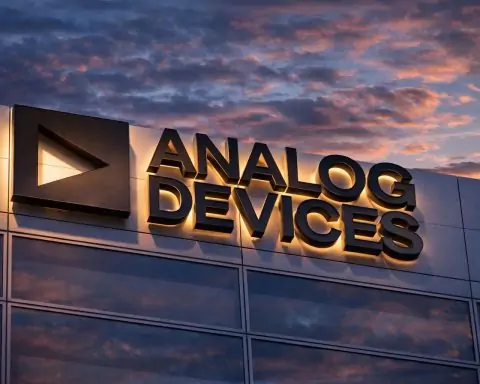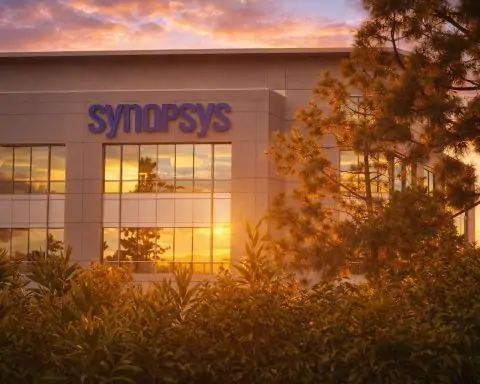Key facts (what changed this week)
- The “Stargate” build‑out just expanded: OpenAI, Oracle and SoftBank unveiled five more U.S. AI data‑center sites, targeting ~7 GW of capacity toward a $500B program. Nvidia also agreed to supply chips and invest alongside the group. [1]
- Power is the bottleneck: PJM—the largest U.S. grid—warns demand from AI data centers is outpacing plant additions; Google struck deals to curb data‑center usage at peaks. The White House signed an executive order to fast‑track AI power/transmission projects. [2]
- HBM memory race heats up: Samsung passed Nvidia’s qualification for advanced HBM3E (12‑high) stacks, setting up a three‑horse race with SK hynix and Micron as HBM4 development accelerates. [3]
- Networking is going “AI‑Ethernet”: Nvidia launched Spectrum‑XGS Ethernet to knit distributed AI “super‑factories,” while Broadcom shipped new Tomahawk/Jericho silicon for 800G–>1.6T fabrics. [4]
- Chips & systems: Nvidia’s Blackwell ramped after a yield fix; AMD detailed Instinct MI350 racks (up to 2.6 exaFLOPS FP4 in a 128‑GPU configuration). [5]
- Agentic AI goes enterprise: Citi began a 5,000‑user pilot of AI agents that autonomously execute multi‑step tasks; McKinsey calls this shift the answer to the “gen‑AI paradox.” [6]
- Models diversify: GPT‑5 launched; Microsoft added Anthropic’s Claude models inside 365 Copilot, signaling a multi‑model era. [7]
- Edge AI arrives: Microsoft’s Copilot+ PCs spread beyond Qualcomm to Intel/AMD; Apple Intelligence continued rolling out across iPhone, iPad and Mac. [8]
- Capex is historic: Microsoft guided to record quarterly capex; Meta lifted 2025 capex to $64–$72B. A Morgan Stanley tally pegs $2.9T in data‑center spend through 2028. [9]
- Markets wobble: Tech led recent pullbacks as AI valuations are questioned; Barron’s urged discipline, while Fox Business highlighted AI‑trade jitters amid U.S. shutdown talk. [10]
The three AI megatrends shaping the next phase
1) Hyperscale compute + energy: AI “super‑factories”
What’s happening. Frontier models, agents and video‑native AI are pushing demand from chips to power, cooling, memory and networking. The Stargate program alone is racing toward multi‑gigawatt campuses; Nvidia committed up to $100B in supply/investment to OpenAI, underscoring how intertwined vendors and model labs have become. [11]
Power & water constraints. PJM’s service area is straining under data‑center load, prompting demand‑response pacts (e.g., Google) and federal fast‑track permitting for plants and transmission. Expect siting to follow available gigawatts and interconnects as much as tax incentives. [12]
Cooling innovation. Microsoft previewed microfluidic cooling—etching channels into silicon to remove heat up to 3× more effectively and cut GPU temperature spikes 65%—potentially enabling denser racks. [13]
Nuclear PPAs. Big Tech is turning to nuclear for 24/7 clean power: Microsoft/Constellation (Three Mile Island restart), AWS/Talen (Susquehanna), plus multiple small‑modular‑reactor (SMR) MOUs across the sector. Oklo surged as a speculative SMR play amid milestones—and volatility. [14]
Memory & packaging. AI performance hinges on HBM and advanced packaging (CoWoS). Samsung recently qualified 12‑high HBM3E at Nvidia; SK hynix says HBM4 production systems are set as the 2026 race begins. Micron guided HBM sales to an $8B run‑rate. [15]
Networking. After years of Infiniband, the balance is shifting: Nvidia Spectrum‑XGS Ethernet targets “giga‑scale” across distributed sites; Broadcom’s Tomahawk/Jericho chips push 100+ Tb/s switching and multi‑DC fabrics. [16]
“We’re building multiple more titan clusters as well… One covers a significant part of Manhattan.” — Mark Zuckerberg on Meta’s AI superclusters. [17]
Why it matters. Morgan Stanley estimates $2.9T of incremental global data‑center spend by 2028. Whether returns match that pace is the investor question of 2025–2027. [18]
2) Agentic AI & the software stack: from copilots to autonomous workflows
From chat to action. Enterprises are piloting AI agents that plan and execute multi‑step work. Citi’s internal pilot spans 5,000 users, with guardrails for cost control and compliance. McKinsey frames this as the cure for the “gen‑AI paradox”—lots of pilots, little P&L impact—by automating full workflows, not just drafts. [19]
Payments for agents. Google announced an Agent Payments Protocol (AP2) with partners like Mastercard, PayPal and AmEx, standardizing how agents get authorization and transact (including stablecoins). This could move autonomous shopping and B2B procurement from demos to production. [20]
Model diversification. We’ve moved beyond single‑vendor stacks: GPT‑5 arrived; Microsoft added Anthropic’s Claude to 365 Copilot and Copilot Studio; Google pushed Gemini 2.0 Flash/Flash‑Lite for low‑latency/low‑cost use. The near‑term pattern is multi‑model, with orchestration picking the right model per task. [21]
“Our multi‑model approach goes beyond choice.” — Satya Nadella on bringing Claude into Microsoft 365 Copilot. [22]
Regulatory backdrop. The EU AI Act timeline is firming up (GPAI obligations beginning in Aug 2025; more in 2026), even as a helpfully detailed Code of Practice may slip into year‑end. Expect model documentation, evals, and operational transparency to become implementation workstreams. [23]
3) Edge AI devices: PCs and phones with real on‑device intelligence
AI PCs mature. Microsoft’s Copilot+ features (Recall testing, Live Captions translation, Paint Cocreator) are rolling out on Intel and AMD systems—beyond the first wave of Snapdragon X laptops. This broadens the install base for local NPUs and offline AI. [24]
Apple Intelligence keeps landing via OS updates across iPhone, iPad, and Mac—anchored in on‑device privacy guarantees and a growing languages roadmap. [25]
Phones level up. Qualcomm’s new Snapdragon 8 Elite Gen 5 touts a faster Hexagon NPU and “agentic” features; MediaTek’s Dimensity 9500 adds compute‑in‑memory NPU for faster, cheaper on‑device generation. [26]
Why it matters. If inference shifts to the edge for latency/cost/privacy, PCs and phones become AI endpoints in distributed workflows—taking pressure off data‑center power while unlocking new consumer and field use cases.
Product stack: how the leaders compare (2025 snapshot)
Training/Inference GPUs & Systems
- Nvidia — Blackwell generation; yield issues resolved; pushing Spectrum‑X networking and “super‑factory” designs that scale across sites. Rubin‑era systems (2026–27) target video/coding‑native workloads. [27]
- AMD — Instinct MI350 (up to 288 GB HBM3E, rack‑scale MI355X platforms). Vendors showcased 128‑GPU liquid‑cooled racks with multi‑exaflop FP4. Software (ROCm 7) and open Ethernet fabrics are AMD’s leverage. [28]
HBM Memory
- SK hynix leads in HBM3E shipments and is readying HBM4 production systems; Micron’s HBM run‑rate is steep; Samsung newly qualified at Nvidia for HBM3E and targets HBM4 volume in 2026. [29]
Networking
- Nvidia Spectrum‑X/‑XGS (AI‑optimized Ethernet, CPO roadmaps) vs. Broadcom Tomahawk/Jericho (open‑Ethernet scaling across/ between data centers). Expect mixed fabrics and OCP‑aligned topologies. [30]
Edge
- Microsoft Copilot+ PCs expand beyond Arm; Apple Intelligence deepens on‑device workflows; Android flagships (Snapdragon/Dimensity) push agentic features. [31]
Economics & risk: can revenues catch capex?
- Spending: Microsoft guided to a record quarter of capex; Meta lifted 2025 to $64–$72B; a cross‑hyperscaler tally points to $364B capex in FY2025 alone. Morgan Stanley sees $2.9T through 2028. [32]
- Returns: Bain analysis (widely discussed) and market commentary warn of a financing gap if utility‑grade workloads don’t scale revenues fast enough. Recent market action shows AI‑led rallies punctuated by valuation pullbacks. [33]
- Productivity payoff: McKinsey estimates $2.6–$4.4T in annual value potential from gen‑AI; Goldman sees ~15% higher labor productivity in developed markets once adopted. The timing—not the existence—of ROI is the question. [34]
Regulation & sustainability to watch
- EU AI Act timelines are holding despite industry pleas; a GPAI code of practice may slip to late‑2025. U.S. regulators, meanwhile, are accelerating permits for AI‑relevant power and grid projects. [35]
- Water & emissions scrutiny is rising: investigations peg steep water footprints for cooling; Microsoft/Nature research quantified lifecycle impacts across cooling methods; expect more reporting/mitigation commitments in 2026 planning. [36]
Strategy guide (public & investor takeaway)
- Assume power is the constraint. Favor vendors/operators with secured megawatts, grid agreements, and advanced cooling. Watch nuclear/renewables PPAs (Constellation/Microsoft; AWS/Talen). [37]
- Bet on memory + packaging. Scarcity in HBM and CoWoS sets the pace more than raw TOPS claims. Recent Samsung qualification tightens the supply stack. [38]
- Model pluralism, not monoculture. Multi‑model orchestration (GPT‑5, Claude 4.x, Gemini 2.0) will be normal; tools that route tasks to the right model (by cost/latency/accuracy) win. [39]
- Follow agents, not just chat. Real ROI emerges when agents automate entire workflows (Citi‑style pilots). Budget for governance/observability as much as inference tokens. [40]
- Edge as a release valve. Copilot+ PCs and Apple Intelligence expand on‑device capacity; expect some inference to shift to endpoints for cost, latency, and privacy. [41]
- Expect volatility. AI‑tied indexes swing with capex headlines and policy noise; Barron’s and Fox Business both flagged caution as shutdown and valuation stories circulate. [42]
Expert voices & notable quotes
- Zuckerberg (Meta) on scale: “We’re building multiple more titan clusters…”—and one site rivals a Manhattan footprint. [43]
- Satya Nadella (Microsoft) on strategy: “Our multi‑model approach goes beyond choice.” [44]
- McKinsey on execution gaps: The “gen‑AI paradox”—widespread use, limited bottom‑line impact—will be solved by agentic automation. [45]
What’s next (90‑day watchlist)
- HBM supply splits for 2026 capacity (who gets HBM4 first, at what yields). [46]
- Nvidia/OpenAI program details (chip delivery cadence; antitrust scrutiny of $100B tie‑up). [47]
- U.S. grid actions from the EO: which transmission projects get priority; new demand‑response frameworks with hyperscalers. [48]
- Agent payments: pilots of AP2 in consumer/retail; early fraud‑/chargeback models. [49]
- Copilot+ & Apple Intelligence feature cadence into the holiday PC/phone cycle. [50]
Methodology & scope
This report synthesizes the three user‑provided references (topic: “what’s next” for AI megatrends, market strategy in a selloff, and current AI‑trade chatter) with corroborating, up‑to‑date reporting and primary announcements from the past days and weeks. Where direct paywalled text could not be accessed, we relied on parallel open reporting and official releases.
References
1. www.reuters.com, 2. www.reuters.com, 3. finance.yahoo.com, 4. investor.nvidia.com, 5. www.reuters.com, 6. www.wsj.com, 7. www.reuters.com, 8. www.theverge.com, 9. www.reuters.com, 10. www.reuters.com, 11. www.reuters.com, 12. www.reuters.com, 13. www.theverge.com, 14. www.reuters.com, 15. finance.yahoo.com, 16. investor.nvidia.com, 17. www.reuters.com, 18. www.reuters.com, 19. www.wsj.com, 20. www.investors.com, 21. www.reuters.com, 22. www.itpro.com, 23. www.reuters.com, 24. www.theverge.com, 25. www.apple.com, 26. www.theverge.com, 27. www.reuters.com, 28. www.amd.com, 29. www.reuters.com, 30. investor.nvidia.com, 31. www.theverge.com, 32. www.reuters.com, 33. www.tomshardware.com, 34. www.mckinsey.com, 35. www.reuters.com, 36. www.bloomberg.com, 37. www.reuters.com, 38. finance.yahoo.com, 39. www.reuters.com, 40. www.wsj.com, 41. www.theverge.com, 42. www.barrons.com, 43. www.reuters.com, 44. www.itpro.com, 45. www.mckinsey.com, 46. www.reuters.com, 47. www.reuters.com, 48. www.whitehouse.gov, 49. www.investors.com, 50. www.theverge.com










